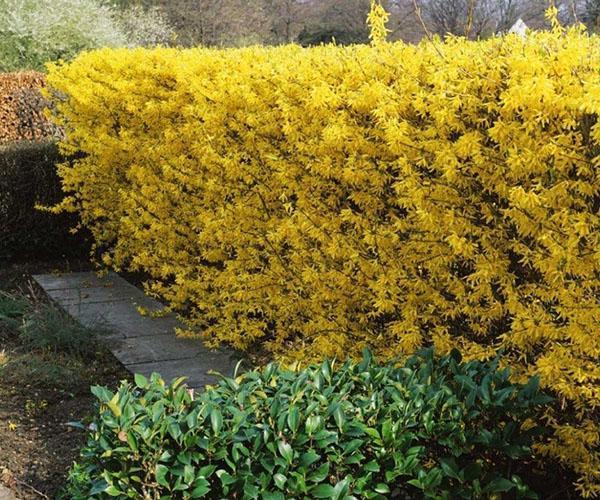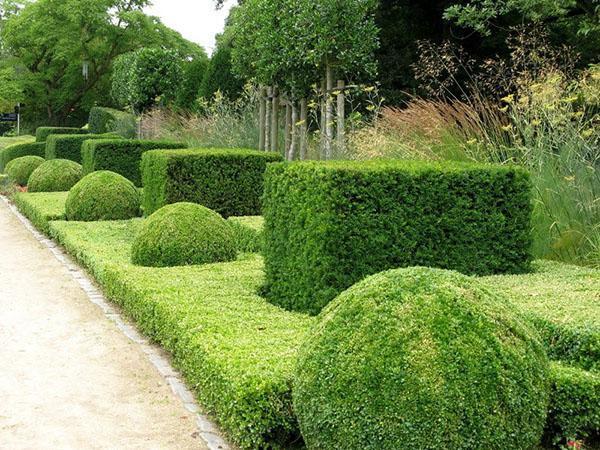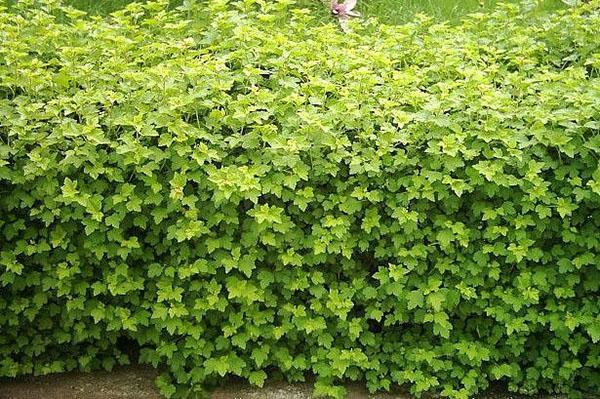What plants are best for a hedge on the site
 The traditional fence of their picket or netting reliably protects the site from prying eyes and, most importantly, from uninvited guests. But only a hedge can harmoniously fit into the landscape, what is the best way to make such a fence?
The traditional fence of their picket or netting reliably protects the site from prying eyes and, most importantly, from uninvited guests. But only a hedge can harmoniously fit into the landscape, what is the best way to make such a fence?
Types of hedges in landscape design

Hedges are used:
- for the external fence of the site;
- to divide the territory inside by functional purpose;
- for framing flower beds and garden paths, lawns and mixborders.
At the same time, plantings can be of different heights and densities, evergreen and retaining foliage only in the warm season. Shrubs for hedges are cut into austere form, or the plants retain their natural shape throughout their life. Fences made of intertwined live shoots of bushes or trees look especially decorative.
To give the hedge proper density or originality, the plants are planted in one, two or three rows.
 When planting a living wall, sometimes not one species is used, but several ornamental plants at once, the main thing is that they have a similar growth rate, frost resistance, as well as requirements for soil composition and care.
When planting a living wall, sometimes not one species is used, but several ornamental plants at once, the main thing is that they have a similar growth rate, frost resistance, as well as requirements for soil composition and care.
An excellent example of this approach would be a hedge made from different types of currants:
- golden or fragrant;
- alpine;
- blood red.
Evergreens for hedges
 Evergreen fences and curbs are very popular for a variety of reasons. Among them:
Evergreen fences and curbs are very popular for a variety of reasons. Among them:
- high density of the green fence;
- decorativeness that persists even in the cold season;
- easy portability of the haircut, which cannot be dispensed with if the hedges are to be given a clear shape;
- slow growth of shoots, which helps to maintain a neat appearance of the shrub for a long time.
 In addition, evergreens for hedges are easy to maintain and versatile. Unfortunately, not many such cultures are adapted to Russian conditions. Almost all of them are conifers.
In addition, evergreens for hedges are easy to maintain and versatile. Unfortunately, not many such cultures are adapted to Russian conditions. Almost all of them are conifers.
The leaders in popularity are:
- thuja;
- spruce of various subspecies;
- common juniper;
- mountain pine dwarf form.
With the help of modern varieties of plants with needles in green, silvery and golden colors, one of the weakest aspects of conifers is avoided - the monotony of the color of the hedge.
Evergreen shrubs, such as juniper, are used in deciduous hedges. Gradually intertwining crowns strengthen each other. The ephedra paints the fence in green tones all year round, and the deciduous culture makes its appearance bright and changeable.
Deciduous crops for hedges in the country
Coniferous hedges are almost a classic. But what is the best way to make a hedge if you want to decorate the site with something original?
 Numerous deciduous crops will come to the aid of the summer resident, which:
Numerous deciduous crops will come to the aid of the summer resident, which:
- well adapted to the climate of the middle zone;
- do not require time-consuming care and special conditions
- painlessly tolerate pruning;
- form a crown dense enough for the fence;
- change their appearance throughout the year, determining the seasonal appearance of the site.
When choosing species for a hedge in the country, it is better to give preference to plants that have proven their unpretentiousness and winter hardiness. Small-leaved varieties with highly branching shoots have proven themselves best as a fence.
The list of such shrubs and small plants is quite large:
- blackthorn;
- yellow acacia or caragana;
- elder;
- small-leaved elm;
- snowberry;
- viburnum;
- spirea;
- cherry laurel;
- chubushnik;
- chokeberry;
- honeysuckle barren varieties;
- euonymus;
- willow;
- barberry;
- hawthorn;
- vesicle;
- dogwood white;
- currant;
- irga.
 At the disposal of the summer resident are dozens of worthy deciduous plants, which not only form a reliable and durable hedge, but also attract attention with variegated foliage, like barberry or turf, lush flowering, characteristic of spire (photo), mock orange, lilac, fieldfare, bubblegum, viburnum or hydrangea. There are many plants with decorative or edible fruits. Such shrubs should include barberry and euonymus, chokeberry, golden currant, irgu and turn. A special charm to the site is given by views with a changing appearance from season to season, like white turf.
At the disposal of the summer resident are dozens of worthy deciduous plants, which not only form a reliable and durable hedge, but also attract attention with variegated foliage, like barberry or turf, lush flowering, characteristic of spire (photo), mock orange, lilac, fieldfare, bubblegum, viburnum or hydrangea. There are many plants with decorative or edible fruits. Such shrubs should include barberry and euonymus, chokeberry, golden currant, irgu and turn. A special charm to the site is given by views with a changing appearance from season to season, like white turf.
Choosing plants for a molded hedge
 Green fences of geometric shapes achieved through regular haircuts look incredibly beautiful. However, not all of the deciduous crops listed above can withstand such a procedure. Which shrub is suitable for a strict hedge?
Green fences of geometric shapes achieved through regular haircuts look incredibly beautiful. However, not all of the deciduous crops listed above can withstand such a procedure. Which shrub is suitable for a strict hedge?
For plantings that will have to maintain the strict forms set by pruning for many years, it is most important to choose plants with frequent branching of shoots and small, quickly renewable foliage. This will help create a semblance of a dense living wall, curb, arch over the gate and other structures.
Not only does hedge trimming do not harm such crops, the crown of shrubs is getting denser from year to year and better copes with the protective function of the fence.
Another feature of strict forms of shrubs suitable for planting is a small annual growth. The choice of plants in this case is considerable. It:
- numerous types and varieties of barberry, differing not only in height, but also in the color of dense foliage.
- hawthorn and bubbly with green or purple foliage;
- cotoneaster;
- alpine and golden currants;
- privet;
- thuja western;
- euonymus;
- japonica.
 No matter how resistant the plants are to clipping, they should be subjected to this procedure very carefully, having a certain skill in such work.
No matter how resistant the plants are to clipping, they should be subjected to this procedure very carefully, having a certain skill in such work.
Having decided to grow a rectangular fence on your site, and then a more rounded one, you will have to stock up on both patience and special hedge scissors.
Free growing hedges in landscaping
 If the painstaking work on the formation of shrubs is not to your liking, but natural beauty is closer, the plants are planted at a short distance from each other so that the crowns intersect, but they do not give a uniform shape. On the side, such a fence seems airy, but inside its intertwining branches create a solid, impenetrable frame.
If the painstaking work on the formation of shrubs is not to your liking, but natural beauty is closer, the plants are planted at a short distance from each other so that the crowns intersect, but they do not give a uniform shape. On the side, such a fence seems airy, but inside its intertwining branches create a solid, impenetrable frame.
What is the best way to make a free-type hedge? Since the plants are not specially cut, their crowns actively grow and can take up a lot of space on the site. Ornamental shrubs in adulthood can have a crown diameter of 50 cm to 3 meters. This is taken into account when selecting crops for planting.
It is difficult to implement such a project in dachas of a small area, but it is possible by planting a low-growing border, for example, from Japanese quince, euonymus, some varieties of thuja and juniper. If the summer resident is not constrained in the area, the list of shrubs and even small trees expands significantly, including flowering, decorative deciduous and fruit species.
 What to plant in a hedge? For an unpretentious green fence, requiring almost no maintenance and wintering well in central Russia, the following is suitable:
What to plant in a hedge? For an unpretentious green fence, requiring almost no maintenance and wintering well in central Russia, the following is suitable:
- hawthorn;
- Tatar honeysuckle;
- vesicle;
- fieldfare;
- barberry, creating a dense prickly protection for the site;
- elder;
- chubushnik;
- spireas of almost all cultivated varieties;
- Hungarian and common lilacs;
- park roses different types and heights.
 In order for a hedge in landscape design to be not only an ornament, but also a real protection, it is strengthened with a second tier. It can be higher than the first or lower.
In order for a hedge in landscape design to be not only an ornament, but also a real protection, it is strengthened with a second tier. It can be higher than the first or lower.
Often the second row is cut into a wall or curb shape to support and restrain hydrangea, lilac, park rose and other plants. In winter, thanks to such support, the hedge retains its density, and when using conifers, opacity.
How to make a hedge?
 The work of laying planting trenches and planting plants begins only after an accurate, well-thought-out hedge plan has been created. For the outer boundaries of the site, green walls up to 2 meters high are more suitable, and in some cases, for example, when adjacent to a busy highway and higher. Inside the site, borders from 50 cm to one meter high are suitable for zoning space and edging.
The work of laying planting trenches and planting plants begins only after an accurate, well-thought-out hedge plan has been created. For the outer boundaries of the site, green walls up to 2 meters high are more suitable, and in some cases, for example, when adjacent to a busy highway and higher. Inside the site, borders from 50 cm to one meter high are suitable for zoning space and edging.
Before making a hedge, based on the average height of the plants and the width of their crown, calculate the required number of shrubs. On each running meter, planted:
- 1-2 large specimens, for example, hawthorn, common lilac, irgi, chokeberry, vesicle;
- 3-5 plants of medium size, which include viburnum, turf, snowberry, barberry, honeysuckle;
- 5-7 shrubs with a low crown, for example, Japanese quince, spirea, certain varieties of euonymus and thuja.
 For single-row planting, a trench 40-50 cm wide and 50-60 cm deep is dug along the line of the future hedge. The more rows of plants, the greater the amount of land work. With each row of shrubs, the planting trench becomes wider by 30 or 40 cm.
For single-row planting, a trench 40-50 cm wide and 50-60 cm deep is dug along the line of the future hedge. The more rows of plants, the greater the amount of land work. With each row of shrubs, the planting trench becomes wider by 30 or 40 cm.
Planting is carried out in mid-spring using 3-year-old coniferous or 2-year-old deciduous seedlings. Such planting material takes root quickly and painlessly. In multi-row hedges, planting is carried out in a checkerboard pattern, adhering to the intervals between the shrubs described above. In molded fences, plants are placed closer to each other, and in free plantings - a little further.
Hello! The article contains excellent photos. It will be a good guide for those who are still hesitant in choosing a design.